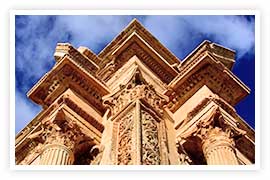
Dating from prehistory to Islamic civilization, the five sites added to the World Heritage list between 1982 and 1986 genuinely proof that Libya has a heritage whose incalculable value belongs to all humanity. Three sites, Cyrene, Leptis Magna and Sabratha, bear witness to the life that flourished in Libya during the Punic, Greek, Roman and Byzantine eras.
The ancient city of Ghadames has a unique architectural heritage of intricately decorated mud-brick houses and covered streets. Finally, the prehistoric site of Tadrart Acacus is a continuation of the culture of Tassili n'Ajjer in Algeria.
Eratosthenes of Cyrene
The mathematician Eratosthenes was born in Cyrene, which is now in Libya. Today he is remembered for his work on prime numbers, particularly his "prime number sieve" which is still an important tool in number theory research. Eratosthenes calculated the distance to the sun and moon and made a surprisingly accurate measurement of the circumference of the Earth. He also measured the tilt of the Earth's axis with great accuracy, obtaining the value of 23 51' 15", and compiled a catalogue of 675 stars
|

